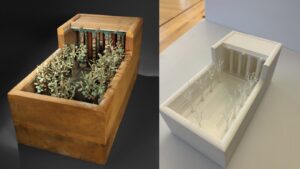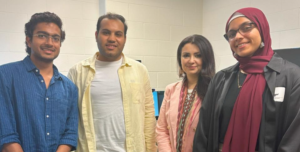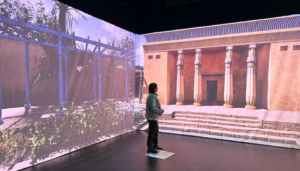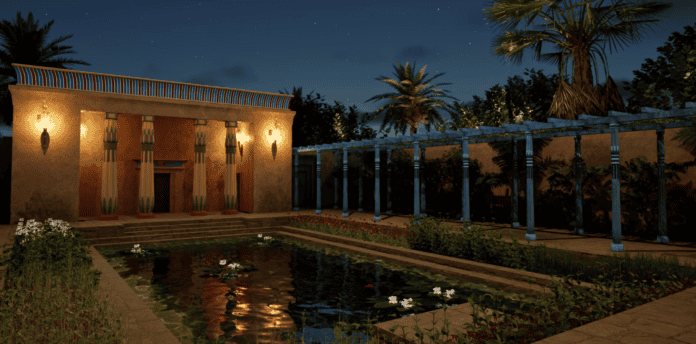Somewhat shy but also inquisitive, Sarah Zulfiqar often found herself wondering why the professor in her studio class sometimes would disappear into a small room at the edge of the studio area.
Then a sophomore and working toward a degree in interior design from Virginia Tech’s School of Design, Zulfiqar eventually asked Eiman Elgewely about the room.
“I was always like, ‘Oh, what is that?’” Zulfiqar said. “And she showed us a few of her projects that she was working on at the time. When my junior year came along, I asked her if I could come in and see what they were doing and maybe help, and she recruited me as a research volunteer. That transferred into a part-time job this year.”
Zulfiqar, from Ashburn, Virginia, now is part of an intriguing interdisciplinary project that involves digitally reconstructing and reimagining artifacts and life in Egypt more than 4,000 years ago. Led by Elgewely, assistant professor in the College of Arts, Architecture, and Design, and funded by the Institute for Creativity, Arts, and Technology (ICAT) and the Center for Human-Computer Interaction, the project includes faculty and students from architecture, interior design, computer science, and creative technologies.
The faculty members include:
- Thomas Tucker, associate professor of creative technologies at the School of Visual Arts
- Ivica Ico Bukvic, director of human-centered design at the Institute for Creativity, Arts, and Technology in the School of Performing Arts
- Amanda Nelson, associate professor of theatre and graduate program director at the theatre department in the School of Performing Arts
- Sang Won Lee, assistant professor of computer science
Specifically, the project – officially “Breathing Life into Meketre’s Tomb Models in VR: A Spatial Storytelling Immersive Experience” – entails taking artifacts and drawings of relics from the tomb of Meketre, an Egyptian official during the 11th dynasty whose tomb was found in Luxor in the late 1800s and excavated by American archaeologist Herbert Winlock in 1920, and using digital technology to allow people to step inside the world of ancient Egypt.
“Currently, these artifacts are displayed at the Metropolitan Museum of Art [in New York City] and at Cairo Museum in Egypt,” Elgewely said. “It’s a very common story of many artifacts that came out of Egypt now scattered in museums worldwide. I have been exploring how digital technology can enable a form of digital repatriation, offering both Egyptians and a global audience access to these cultural gems.”

Doing the research
Winlock and his team discovered 22 fragments of Meketre’s wooden coffin. In addition, one of the rooms within the tomb revealed 24 small wooden boxes with hand-carved and painted wooden people who were working at various tasks, including as cattle herders, butchers, bakers, weavers, carpenters.
The boxes represented the workshops and courtyards where tasks took place. Ten model ships with wooden people surrounded the boxes, revealing that Meketre possibly enjoyed trips down the Nile River.
All this offered a glimpse of daily life at the Meketre estate. Winlock and his staff carefully preserved each artifact and manually made drawings of each.
Those drawings prompted Elgewely to put together a Virginia Tech team to create digital replicas, using digital technologies such as 3D printing. They created a 3D visual model of Meketre’s garden courtyard, but to do so, they first needed more information.
That involved researching pictures and drawings and even reading text from thousands of years ago because drawings were in shortly supply. The team found a floor plan and basically transformed the garden into a 3D model based on the research and the logical placement of items.
“I was in charge of finding as many authentic paintings as I could find relating to Egyptian gardens,” Zulfiqar said. “I did a lot of research on native plants, trees, flora, and fauna. We put that all into our reconstruction and made it as historically accurate as possible.”
“We did extensive research based on references from tombs and temples in ancient Egypt,” Elgewely said. “Drawings showed us a pool, the type of fish they use, the type of trees, and the very exact types of plants that were in ancient Egypt. You can see how we apply textures, materials, lighting from that era, capturing even the symbolism in the garden and architectural design. Many stories come to life through this 3D visualization. We are also developing authentic sound effects, including accurate bird sounds, to create a fully multisensory immersive environment.”
Creating a multifunctional model
Deepak Gupta ’24 pursued a master’s degree in computer science from Virginia Tech solely to work in the areas of virtual reality (VR) and machine learning. The India native even researched professors working in these areas before making his college decision, and he and several others teamed with Elgewely on another project more than a year ago when a group created a 3D virtual reality experience of the house of Sheikh Isa from Bahrain.

The team created a 360-degree video and a virtual reality app as part of the Sheikh Isa project and presented the entirety of the project at ICAT Day last year. ICAT funded that project as well.
Gupta jumped at the opportunity to work with Elgewely on the Meketre garden project, which eventually became a 3D model that could be used in animation, on a website, or as a VR application.
“I really like storytelling,” Gupta said. “I believe the progression went from folklore and old humans telling stories to books to audio to video and movies. The next progression was virtual reality.”
Gupta used Unreal Engine, which is a 3D creation tool, to create the interactive exhibition and to add the interactions. For example, he used artificial intelligence (AI) to guide the behavior of fish in the garden pool. Additionally, the fish follow the user in both the exhibition and the VR headset experience.
A version of the project was unveiled at the Virginia Tech Science Festival held at the Moss Arts Center in November. Young children were allowed to put on the VR headset and view Meketre’s garden while gaining a bigger perspective of Egyptian life in those days.
“The kids loved it,” Gupta said. “They were trying to catch the fish and play with them. So we thought, ‘Why can’t they catch the fish?’ I wondered if maybe they could — let’s have them catch the fish so they can play with them. There are flowers around the pond, so maybe they can pick some. These are the things we then added.
“We also have the garden in two scenarios. There’s a day scene and a night scene, and with a night scene, you have a torch, a flame outdoors, and you can navigate around. We keep adding new elements to it. Our initial plan was smaller, but as we go, we add more elements.”
Continued commitment to learning
Projects such as these expose Virginia Tech students to experiences that are hard to replicate in a classroom setting. They work with new software and hardware, and they collaborate with students from other disciplines, learning how to communicate and exchange ideas.
“How often do you have the opportunity to have an interior designer work with a computer science student?” Elgewely said. “It doesn’t happen very often. That is something very important.”
The project also prepares participants for futures in their respective industries. Gupta now works in the field of AI as a software engineer.

“In my job, I work with AI, and I really love it,” he said. “When I came to the States, I got an opportunity to work on these things, which has been incredibly rewarding.”
Zulfiqar graduates in May and continues her career search. She wants to work in the hospitality or education sectors, and she knows that a lot of design firms are experimenting with AI and VR.
Her experience on the Meketre project hopefully gives her an advantage.
“People are asking, ‘How can we experience the space before it’s even built?’” Zulfiqar said. “So there’s a large future. There’s a lot of scope for AI in terms of helping us with the design process and then using virtual reality to engage clients a little bit more and maybe build a different clientele.
“I love designing spaces, doing all the projects. I love to do all of that, but I do think this [AI and VR] is the future of design.”
Future way of learning
The team continues to add the final elements to the Meketre project, such as voice narration in different languages and music. Team members are planning a complete exhibition of the project in the Cube within the Moss Arts Center on ICAT Day held May 5, allowing the public to experience the work firsthand.
Elgewely, a native of Egypt, has worked on such projects in the past, including helping to create 3D documentations of the pyramid of Giza and the Luxor temple. She dreams of going bigger. She wants to increase size, scope, and scalability, with more information and more complexity, though doing so hinges on increased funding.
At the least, however, Elgewely and her team have constructed a new way of learning to expose future generations to ancient cultures.
“Growing up in Egypt is like growing up in an architecture history book, being exposed to all of this, but I noticed that people still need to be more engaged,” she said. “They’re not very much interested in visiting museums to view artifacts behind glass cases. Perhaps there are new ways now to approach this, especially with generations of young people growing up with technology. Maybe we can truly help them really understand and appreciate it with new media.”
By Jimmy Robertson

